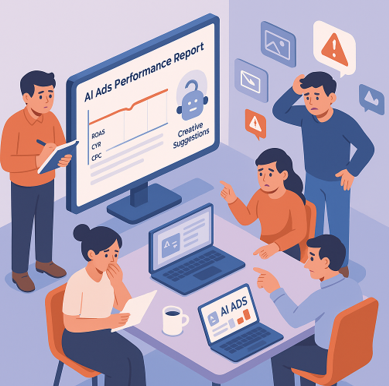So, your AI ads were crushing it. You plugged in your best AI ad generator, let the campaigns fly, and watched the AI ads results roll in. But now? Things have stalled. ROAS is flat, CTR is dipping, and even your AI ad creator looks like it’s run out of ideas.
You’re not alone. AI ads often plateau after initial success. Let’s break this down.
Understanding AI Ads Performance Plateaus
You know, after pushing hard with that shiny new AI ad creator, these flat lines on your AI ads dashboard aren’t as rare as you might hope. AI ads typically show strong early momentum, but plateaus happen when your AI ad generator gets stuck optimizing for the same patterns.
Even the best AI advertising generator can get trapped in a loop.
What to monitor in your AI ads:
- Compare CTR, CPA, ROAS, and frequency month-over-month.
- Segment AI ads performance by audience and placement.
- Use your AI ad generator to set alerts for key KPI drops.
Signs Your AI Ads Are Plateauing
Let’s face it, even the smartest AI ads generator can’t dodge fatigue forever:
- CTR and engagement plateau when users grow desensitized to your AI ads, even if they’re auto-refreshed.
- CPA or CPC creeps up while conversions stagnate—classic AI ads inefficiency.
- Flat ROAS? Your AI ads might be recycling past converters, not attracting new ones.
- Ad frequency spikes with no lift in engagement—the AI ads are wearing out their welcome.
Run weekly performance checks on your AI ad generator. And be sure to benchmark current AI ads against prior performance phases.
When an AI Ads Plateau Is Real—Versus Just a Blip
You might notice your AI ad generator suggests optimizations, but a few days later, metrics self-correct. That’s not always a plateau—AI ads can dip due to seasonality, algorithm shifts, or new audience tests.
Before overhauling your AI ads:
- Check market conditions or holidays.
- Wait through AI ads learning phases.
- Use geo-holdouts or A/B splits within your AI ad generator to isolate real drops.
AI ads should be evaluated holistically, including funnel metrics like brand searches and assisted conversions.
Key Metrics to Watch in AI Ads During a Plateau
When AI ads flatten, focus on these signals:
- Incremental ROAS: AI ads can inflate ROAS when retargeting easy wins. Run lift tests using geo-based control groups.
- Conversion quality: AI ads might bring quantity, not quality. Connect CRM data to evaluate lead value.
- Engagement depth: In AI ad analytics, watch video views, scroll depth, and session duration—they show real interest.
- Brand lift: Some AI advertising generators now include brand lift surveys. Use them to validate awareness campaigns.
- Frequency & saturation: AI ads shown too often become background noise. Set frequency caps inside your AI ad creator platform.
Build a unified dashboard combining AI ads data with Google Analytics and your CRM to uncover what’s really going on.
How to Break Through AI Ads Performance Plateaus
AI ads can only iterate within the data they know. If that data is stale, so are the results. Here’s how to shake things up:
1. Revamp Your AI Ads Creatives
Refresh not just the copy but the angle. AI ads love iterations, but they need bold new directions—emotion, storytelling, unexpected hooks.
2. Evolve Your AI Ads Audience
Many AI ad generators stick to lookalikes or past converters. Instead, layer behaviors, interests, and broader intent signals for fresher reach.
3. Align Landing Pages with AI Ads
No matter how sharp your AI ads are, if the landing page doesn’t match the promise, conversions tank. Update messaging and UX regularly.
4. Run Controlled AI Ads Experiments
Use your AI advertising generator’s A/B and geo-holdout features. Measure actual lift. Don’t just take reported ROAS at face value.
5. Make AI Ads Multichannel-Aware
Feed learnings from email, search, CTV, and organic content into your AI ads strategy. Syncing signals keeps your AI ad generator relevant.
6. Control AI Ads Frequency
Fatigue is real. AI ad generators often need a manual nudge. Cap frequency, rotate creatives, and monitor audience overlap.
7. Human Oversight for AI Ads
You bring context that AI doesn’t have. Weekly reviews help spot patterns your AI ad generator might overlook.
Common Community Questions About AI Ads
1. Why do AI ads stop working after a few weeks?
They often converge on a single pattern that worked once. Without creative or audience refresh, AI ads stagnate.
2. Can free AI ad generator tools fix performance plateaus?
They help, but deeper results come when you combine AI ads with manual testing and insights from other tools.
3. How can I test AI ads incrementality?
Geo holdouts or time-based splits. Many AI advertising generators now support this.
4. Should I increase spend on AI ads when they plateau?
Only after you fix creative fatigue and targeting issues. More budget won’t solve an underlying AI ads problem.
5. Can overlapping audiences hurt AI ads?
Yes. AI ads often oversaturate segments. Use exclusions and clean segmentation.
What Most People Miss About AI Ads Plateaus
Marketers often rely too heavily on reported ROAS and ignore incrementality. AI ads can look profitable but fail to deliver new value.
Model convergence is another blind spot. When your AI ad generator keeps finding the same solution, performance flatlines.
Attribution is complex too. AI ads may get credit for conversions that actually came from other channels. Cross-device attribution fixes this.
Many brands also fail to refresh AI ads creative regularly. Without audits, AI ad fatigue sets in fast.
And finally, most ignore creative insights inside AI ad generators. Dig into which combinations of headline, image, and CTA work best.
Final Thoughts on AI Ads: Keep It Fresh or Fall Behind
AI ads are powerful, but not perfect. They don’t innovate unless you push them.
Plateaus are part of the game. But now, you know how to break through. From creative refresh to smarter testing and manual intervention, your AI ads can keep growing.
Because let’s be real: AI doesn’t get bored. But your audience definitely does.


